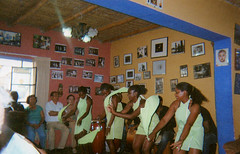
The late Ronaldo Campos, founder of the world renown dance troupe Perú Negro, the Ambassadors of Black Perú
It was in 2003 when I first saw the dance troupe Perú Negro (Black Perú) at the Yerba Buena Gardens in San Francisco. In 2005, I made my first of four subsequent visits to Perú over a period of five years. With my having met more than my share of Afro-Peruvians, particularly in Southern Perú, and after hearing about the Yungas of Northern Perú, I've come to the conclusion that Afro-Peruvians, like African-Americans, come in a wide range of colors; from light, bright, and darn near white, to deep dark complexions. This was the Perú Negro I saw in Yerba Buena Gardens.
However in 2006 and 2008, when Perú Negro performed at Zellerbach Hall on the Berkeley campus of the University of California, I noticed something very strange. Most of the performers were of light complexion and did not show much of the diversity of skin tones, which represented the blacks that I personally saw in Perú. With racial discrimination being so prevalent against blacks, Asians, and descendants of the Inca and Aymara people, why is such racial discrimination being practiced against darker Afro-Peruvians; the very people for whom the late founder Ronaldo Campos promoted as the ”ambassadors of black Perú?” While I was in Perú, I seldom saw blacks working in shops, restaurants, hotels, or working in public transportation. Even in the province of Chincha, a heavily populated black area, blacks were underrepresented.
Any of these dancers from El Carmen, the hub of Black Peruvian culture, would jump at the opportunity to join Perú Negro.
An Afro-Peruvian friend, now living in Toronto, explained that there aren't as many black people left in Perú due to intermarriage. I thought she made a good point because I did see a lot of interracial marriages and interracial children. Personally, I think multi-racial performers with some African blood should certainly be included in Perú Negro, but not overwhelm it; just my humble opinion.
Related Posts on Black Perú


Who says they overwhelm it? There is no exclusion. It is quite simple, those that sign up for the dance troupes dance. Some troupes might have lighter members, others darker members. But because intermarriage is quite common, the darker skinned Afro-Peruvian women are rarer.
ReplyDeleteIts because the multiracial afro peruvians are way more than the "really" dark black peruvians
ReplyDeleteAnd i supposse than the "really" dark black peruvians that sign up in "PERU NEGRO" are few in comparison .
¿Quiere decir que hay muchisimo más peruanos que son multiracial que los peruanos negros?
ReplyDeleteYes, thats because in peru you can be afroperuvian without being black.
ReplyDeleteEl el Peru no existe the one drop rule
OK, ya entiendo. Se puede ser de otro color de negro, pero todavía tiene alguna de la sangre negra. Bueno, Hay todavía muchos negros en en El Carmen de Chincha que tienen bastante habilidades para Perú Negro. Vea los dos fotos nuevos arriba. Yo estuve allí y saqué esos fotos.
ReplyDeleteBueno, talvez ellos nunca se hallan acercado a peru negro, por eso es que no estan ahi . Pero la verdad es que talvez no haya ninguna discriminacion , aparte de Peru Negro, existen muchos otros grupos de danza afroperuana, pero que solo son conocidas dentro del Peru , no internacionalmente como Peru Negro, talvez los muchachos de las fotos pertenecen ya a un grupo de Danza.
ReplyDeletePD: Escribes como cubano XD nice :D
PD2: You should totally see this video
http://www.youtube.com/watch?v=-p0KasRbUqw
Jajsjaja, ¿Escribo como Cubano? Jajajaja. No señor, todavía aprendiendo Español. Pero usted hace una buena punto que las muchachas arriba pertenecen a otro grupo.
ReplyDeleteYo le ví el video de youtube. Yo conozco bien los Ballumbrosios. Yo vivo con ellos cada vez yo vengo a Perú. Los dos fotos allí han sacados en la casa de los Ballumbrosios.
There is one more thing to point out here. The great majority of the current members of Peru Negro are actually children, grandchildren (and soon great grandchildren) of Ronaldo Campos and the other founding members of the group. The group has always been first and foremost a family affair and the dances have been taught from one generation to the next as part of an oral tradition. What has happened is that many of their parents married people who are not Afro-Peruvians so they younger performers are lighter skinned.
ReplyDeleteSomething similar is happening with the Ballumbrosio family. Should Chebo Ballumbrosio's biracial daughter, for example, have less of a right to perform the music and dance that her cousins also know because her skin is lighter?
So it's a “family” thing? Thanks for the “clarification!.”
ReplyDeleteDear Anonymous,
ReplyDeleteAs a frequent visitor to Perú, I'd like to see more black Peruvians making money in government, business, law enforcement, etc. Just as non-black Peruvians are making money in Afro-Peruvian music and dance. That sounds fair, doesn't it?